
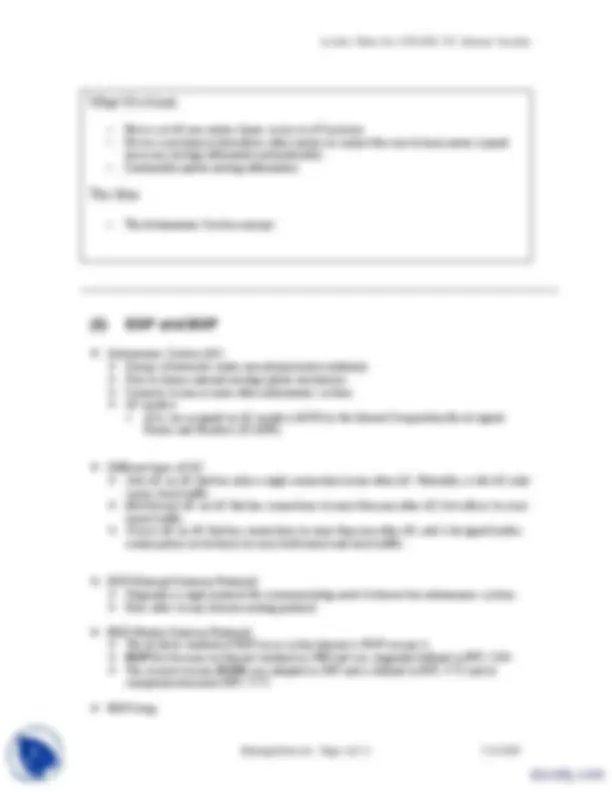
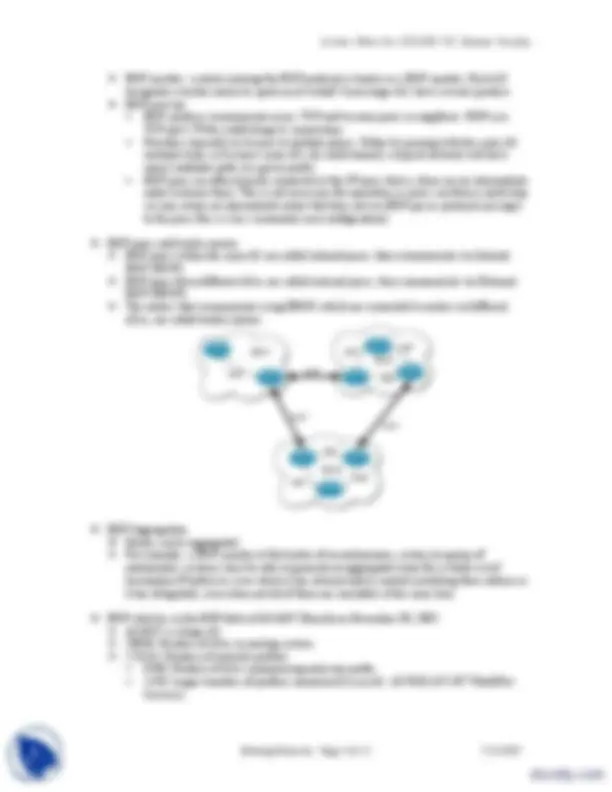
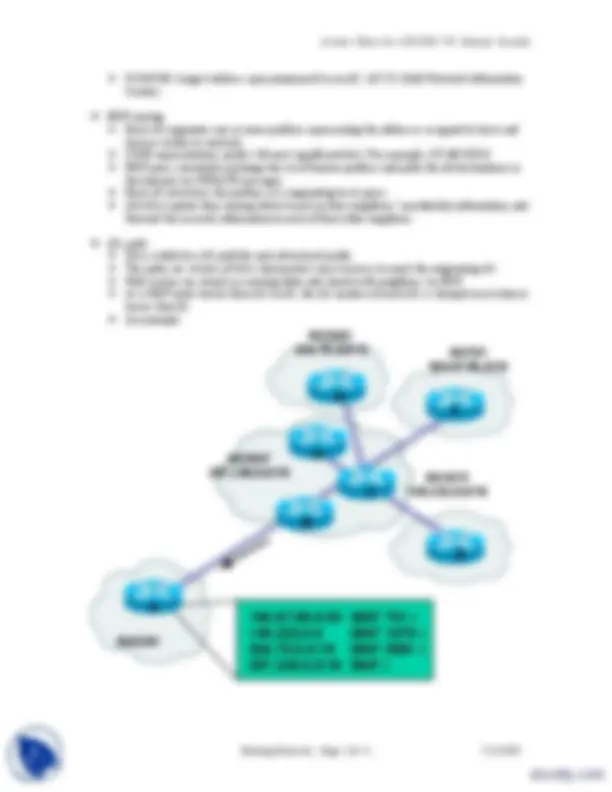
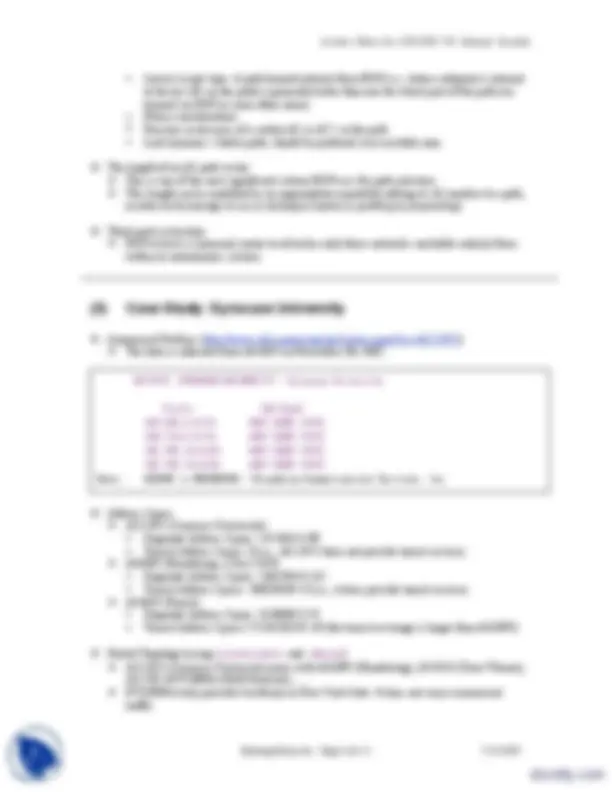
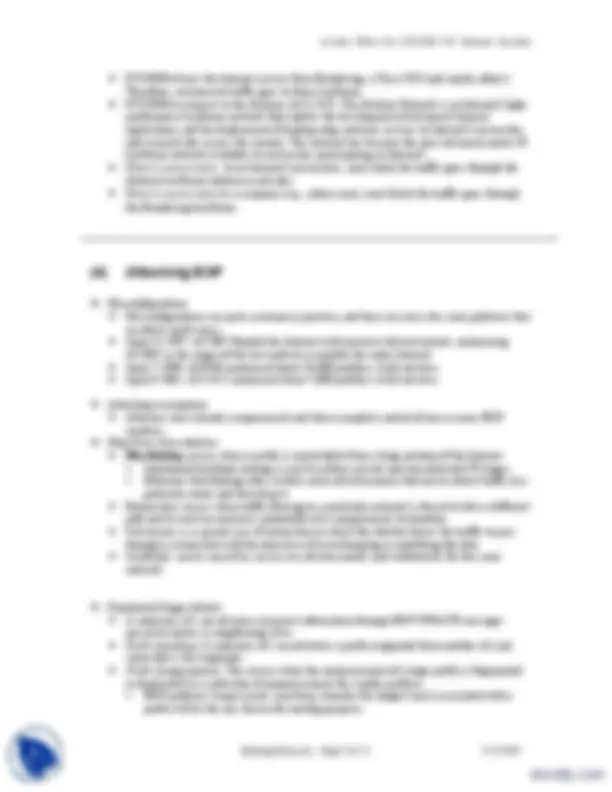
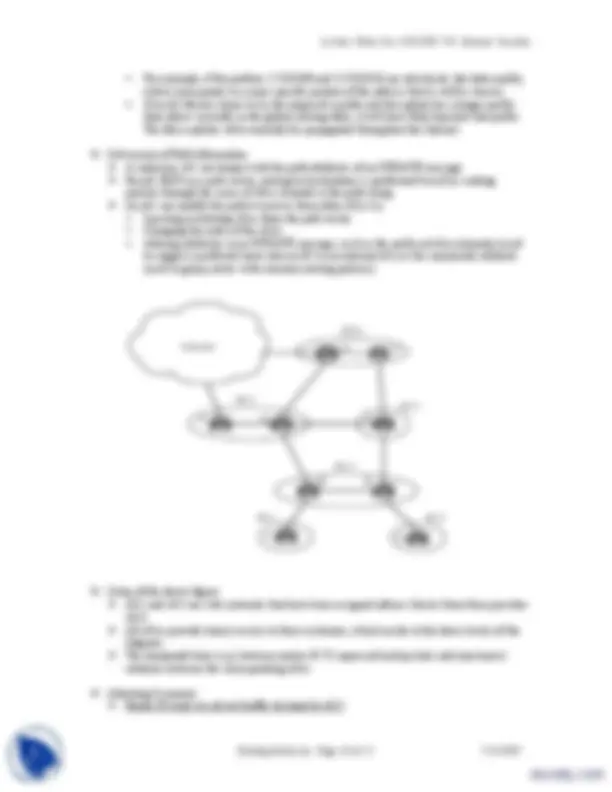
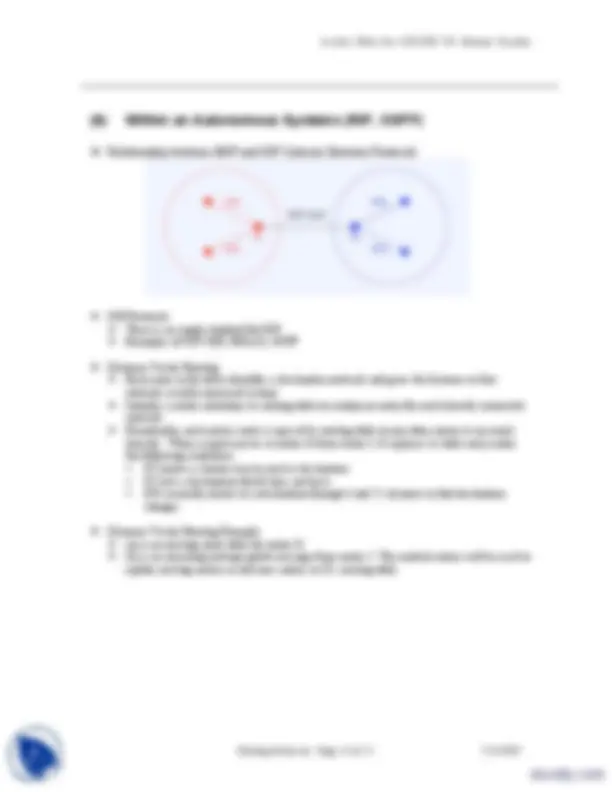
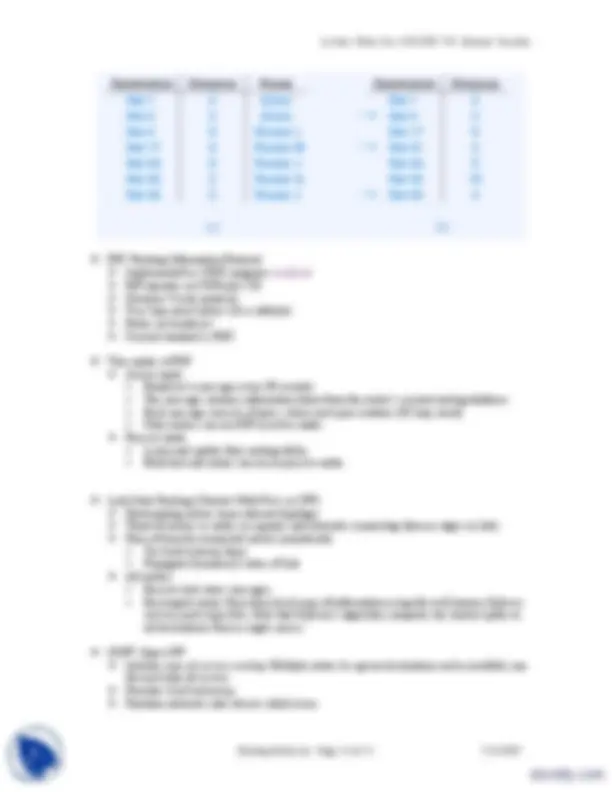
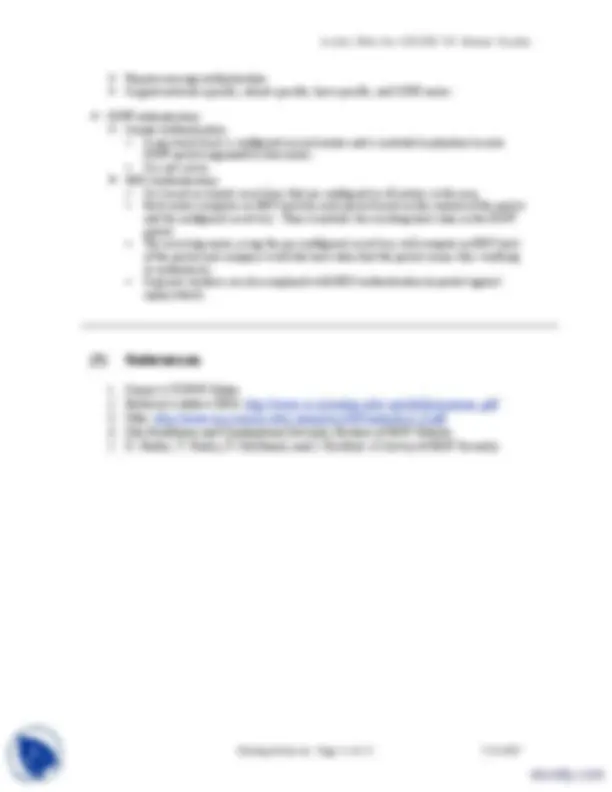


Study with the several resources on Docsity

Earn points by helping other students or get them with a premium plan


Prepare for your exams
Study with the several resources on Docsity

Earn points to download
Earn points by helping other students or get them with a premium plan
Community
Ask the community for help and clear up your study doubts
Discover the best universities in your country according to Docsity users
Free resources
Download our free guides on studying techniques, anxiety management strategies, and thesis advice from Docsity tutors
This lecture was delivered by Inayat Khan at Jawaharlal Nehru University for Computer Networks course. It includes: Routing, Protocols, Static, Dynamic, Core, Architecture, Partial, Information, Backbone, Cores, Autonomous, System
Typology: Slides
1 / 15

This page cannot be seen from the preview
Don't miss anything!










Routing Protocols: Page 1 of 15 7 / 23 / 2007
Static routing versus dynamic routing Static routing Fixes routes at boot time Useful only for simplest cases Dynamic routing Table initialized at boot time Values inserted/updated by protocols that propagate route information Necessary in large internets Routing with partial information The routing table in a given router contains partial information about possible destinations For the unknown destinations, forward them to the default router. Potential problem: some destinations might be unreachable. Original Internet and the problem if the core routers are allowed to have default routes. Core routing architecture with single backbone. Assumes a centralized set of routers that know all possible destinations in an internet. Non-core routers use the core routers as their default routers. Work best for internets that have a single, centrally managed backbone. Inappropriate for multiple backbones. Disadvantage Central bottleneck for all traffic Not every site could have a core router connected to the backbone: how do they get routing information? No shortcut route possible: non-core routers always forward their traffic to the default routers even though another core router provides a better route. This is because the non- core routers do not know which one is better without full knowledge of all possible destinations. Does not scale, because core routers must interact with each other.
Routing Protocols: Page 2 of 15 7 / 23 / 2007 Multiple backbones At beginning, NSFNET attached to the ARPANET backbone through a single router in Pittsburgh, routing is easy: routers inside NSFNET send all non-NSFNET traffic to ARPANET via the Pittsburgh router Multiple connections were added later, and routing becomes complicated Example: From host 3 to host 2, there are many possible routes, which one to choose? Partial cores are not a solution! It is possible to have a single core system that spans multiple backbone networks. It is not possible, however, to partition the core system into subsets that each keep partial information without losing functionality. The following figure illustrates the problem.
Routing Protocols: Page 4 of 15 7 / 23 / 2007 BGP speaker: a router running the BGP protocol is known as a BGP speaker. Each AS designates a border router to speak on its behalf. Some large ASs have several speakers. BGP peering : BGP speakers communicate across TCP and become peers or neighbors. BGP uses TCP port 179 for establishing its connections. Providers typically try to peer at multiple places. Either by peering with the same AS multiple times, or because some ASs are multi-homed, a typical network will have many candidate paths to a given prefix. BGP peers are often directly connected at the IP layer; that is, there are no intermediate nodes between them. This is not necessary for operation, as peers can form a multi-hop session, where an intermediate router that does not run BGP passes protocol messages to the peer (this is a less commonly seen configuration). BGP peers and border routers. BGP peers within the same AS are called internal peers; they communicate via Internal BGP (IBGP). BGP peers from different ASes are called external peers; they communicate via External BGP (EBGP). The routers that communicate using EBGP, which are connected to routers in different ASes, are called border routers. BGP Aggregation
For example, a BGP speaker at the border of an autonomous system (or group of autonomous systems) must be able to generate an aggregated route for a whole set of destination IP addresses over which it has administrative control (including those addresses it has delegated), even when not all of them are reachable at the same time. BGP statistics in the BGP table of AS4637 (Reach) on November 30, 2005 AS4637 is a large AS. 20946: Number of ASes in routing system 173244: Number of network prefixes 8700: Number of ASes annonuncing only one prefix 1458: Largest number of prefixes announced by an AS: AS7018 (AT &T WorldNet Services)
Routing Protocols: Page 5 of 15 7 / 23 / 2007 91316736: Largest address span announced by an AS: AS721 (DoD Network Information Center). BGP routing Each AS originates one or more prefixes representing the addresses assigned to hosts and devices within its network. CIDR representation: prefix / (# most significant bits). For example, 192.68.0.0/16. BGP peers constantly exchange the set of known prefixes and paths for all destinations in the Internet via UPDATE messages. Each AS advertises the prefixes it is originating to its peers. All ASes update their routing tables based on their neighbors’ reachability information, and forward the received information to each of their other neighbors. AS_path ASes establish a AS path for each advertised prefix The paths are vectors of ASes that packets must traverse to reach the originating AS. Path vectors are stored in a routing table and shared with neighbors via BGP. As a BGP route travels from AS to AS, the AS number of each AS is stamped on it when it leaves that AS. An example:
Routing Protocols: Page 7 of 15 7 / 23 / 2007 Routing Policy BGP enforces routing policies, such as the ability to forward data only for paying customers through a number of protocol features. Routing policies are related to political, security, or economic considerations. A multihomed AS can refuse to act as a transit AS for other AS's. (It does so by only advertising routes to destinations internal to the AS.) A multihomed AS can become a transit AS for a restricted set of adjacent AS's, i.e., some, but not all, AS's can use the multihomed AS as a transit AS. (It does so by advertising its routing information to this set of AS's.) An AS can favor or disfavor the use of certain AS's for carrying transit traffic from itself. BGP uses the attribute values in UPDATE messages to help enforce policies. Policies configured in a BGP router allow it to do the following: Filter the routes received from each of its peers Filter the routes advertises to its peers Select routes based on desired criteria Forward traffic based on those routes Setting policy often involves techniques to bias BGP’s route selection algorithm. Multiple Path BGP could possibly receive multiple advertisements for the same route from multiple sources. BGP selects only one path as the best path. When the path is selected, BGP puts the selected path in the IP routing table and propagates the path to its neighbors. BGP Path Selection. One of the major tasks of a BGP speaker is to evaluate different paths from itself to a set of destination covered by an address prefix, select the best one, apply appropriate policy constraints, and then advertise it to all of its BGP neighbors. Metric Each AS can use its own routing protocol Metrics differ (hop count, delay, etc) BGP does not communicate or interpret distance metrics. The only interpretation is the following: “My AS provides a path to this network”. Where there are more than one feasible paths to a destination, all feasible paths should be maintained. Each feasible path is assigned a preference value. The process of assigning a degree of preference to a path can be based on several sources of information:
Routing Protocols: Page 8 of 15 7 / 23 / 2007 Lowest origin type: A path learned entirely from BGP (i.e., whose endpoint is internal to the last AS on the path) is generally better than one for which part of the path was learned via EGP or some other means. Policy considerations
Link dynamics: Stable paths should be preferred over unstable ones. The length of an AS path vector This is one of the most significant criteria BGP uses for path selection This length can be modified by an organization repeatedly adding its AS number to a path, in order to discourage its use (a technique known as padding or prepending ). Third party restriction EGP restricts a (noncore) router to advertise only those networks reachable entirely from within its autonomous systems.
Announced Prefixes (http://www.cidr-report.org/cgi-bin/as-report?as=AS11872) The data is collected from AS4637 on November 30, 2005. Address Space AS11872 (Syracuse University) Originate Address Space: 131584/14. Transit Address Space: 0 (i.e., AS11872 does not provide transit service). AS6395 (Broadwing, a Tier-I ISP) Originate Address Space: 1365504/11. Transit Address Space: 7683584/9.13 (i.e., it does provide transit service) AS4637 (Reach) Originate Address Space: 314880/13. Transit Address Space 1713352013/1.33 (the transit coverage is larger than AS6395) Partial Topology (using traceroute and whois) AS11872 (Syracuse University) peers with AS6395 (Broadwing), AS4323 (Time Warner), AS1785 (NYSERNet R&E Network), …. NYSERNet only provides backbone in New York State. It does not carry commercial traffic. REACH Reach Network Border AS
Routing Protocols: Page 10 of 15 7 / 23 / 2007 For example, if the prefixes 12.0.0.0/8 and 12.0.0.0/16 are advertised, the latter prefix, which corresponds to a more specific portion of the address block, will be chosen. If an AS falsely claims to be the origin of a prefix and the update has a longer prefix than others currently in the global routing table, it will have fully hijacked that prefix. The false updates will eventually be propagated throughout the Internet. Subversion of Path Information A malicious AS can tamper with the path attributes of an UPDATE message. Recall: BGP uses path vector; routing to destinations is performed based by sending packets through the series of ASes denoted in the path string. An AS can modify the path it receives from other ASes by Inserting or deleting ASes from the path vector Changing the order of the ASes Altering attributes in an UPDATE message, such as the multi-exit discriminator (used to suggest a preferred route into an AS to an external AS) or the community attribute (used to group routes with common routing policies) Setup of the above figure AS1 and AS2 are stub networks that have been assigned address blocks from their provider AS3. All ASes provide transit service to their customers, which reside at the lower levels of the diagram. The horizontal lines (e.g. between routers B-V) represent backup links and non-transit relations between the corresponding ASes. Attacking Scenarios: Router B wants to subvert traffic destined to AS2:
Routing Protocols: Page 11 of 15 7 / 23 / 2007 It could announce a fake route, announcing that it has a direct connection to AS2. It could also claim ownership of the address blocks originated by AS2. Routers A and R would then forward traffic destined to AS2 to B. B can de-aggregate the prefix announced by AS2 to two prefixes that are longer by one bit, while keeping the AS-PATH to AS2 the same. In that case, traffic originating anywhere in the Internet, except in AS2, and destined to AS2 would be forwarded towards router B. If AS2 owned a prefix that was aggregated with other prefixes by the provider AS2, then B could simply announce the original AS2 prefix. Note that a compromised BGP speaker can use de-aggregation to blackhole a victim network anywhere in the Internet, regardless of the proximity between the two. Redirect traffic: Normally, B should announce the AS1 route that goes through {AS1, AS3, AS4}. Instead, B can propagate that route only to A indicating that it should not be announced any further, and announce the padded route that goes through AS5 to R. Update modifications Suppose that AS3 uses the link V-N only for backup purposes because it is cheaper to use link B-M instead. To achieve this, router N can pad the UPDATEs going to V, making the corresponding AS-PATH longer. Assume that R is compromised, and that it wants to redirect traffic to AS3 through the more expensive link V-N. R can drop the padding in the route that includes the {AS5, AS3} link, and instead pad the route that includes the {AS4, AS3} link (or simply not announce it). This would force traffic for AS3 to take the more costly V-N route. Route flapping and Route dampening If a router goes offline frequently, the routes it advertises will disappear and reappear in peer routing tables. This is called route flapping. In order to lower burden, unstable routes are often penalized through a process called route dampening. Neighboring routers will ignore advertisements from the router for an increasing amount of time, depending on how often the route flapping occurs. Attacks using route flapping Can be used to trigger route dampening for a victim network at an upstream router. This can be done by withdrawing and re-announcing the target routes at a sufficiently high rate that the neighboring BGP speakers dampen those routes. A dampened route would force the traffic to the victim AS to take a different path, enabling traffic redirection. The dampening can be triggered when a single route flap forces BGP peers to consider several backup paths, causing a large number of additional withdrawals and announcements. Congestion-induced BGP session failures When the BGP peers are under heavy congestion, the TCP-based BGP sessions can be so slow that they are eventually aborted, causing thousands of routes to be withdrawn. When BGP sessions are brought up again, routers must exchange full routing tables, creating large spikes of BGP traffic and significant routing convergence delays. For example, studies have shown that during the adverse effects of the Code Read and Nimda worms of 2001, BGP traffic “exploded” by a factor of 25 (later, another study has shown that over 40% of the observed BGP updates are due to other reasons). Other Denial of Service Attacks
Routing Protocols: Page 13 of 15 7 / 23 / 2007
IGP Protocols There is no single standard for IGP. Examples of IGP: RIP, HELLO, OSPF Distance-Vector Routing Each entry in the table identifies a destination network and gives the distance to that network, usually measured in hops Initially, a router initializes its routing table to contain an entry for each directly connected network. Periodically, each router sends a copy of its routing table to any other router it can reach directly. When a report arrives at router K from router J, K replaces its table entry under the following conditions: If J knows a shorter way to reach a destination If J lists a destination that K does not have If K currently routers to a destination through J and J’s distance to that destination changes. Distance-Vector Routing Example (a) is an existing route table for router K (b) is an incoming routing update message from router J. The marked entries will be used to update existing entries or add new entries to K’s routing table.
Routing Protocols: Page 14 of 15 7 / 23 / 2007 RIP: Routing Information Protocol Implemented by UNIX program routed RIP operates on UDP port 520 Distance-Vector protocol Uses hop count metric (16 is infinity) Relies on broadcast Current standard is RIP Two modes of RIP Active mode: Broadcast a message every 30 seconds. The message contains information taken from the router’s current routing database. Each message consists of pairs, where each pair contains (IP, hop count) Only routers can run RIP in active mode. Passive mode Listen and update their routing tables. Both host and router can run in passive mode. Link-State Routing (Shortest Path First, or SPF) Participating routers learn internet topology Think of routers as nodes in a graph, and networks connecting them as edges or links Pairs of directly-connected routers periodically Test link between them Propagate (broadcast) status of link All routers Receive link status messages Recompute routes from their local copy of information using the well-known Dijkstra shortest path algorithm. Note that Dijkstra’s algorithm computes the shortest paths to all destinations from a single source. OSPF: Open SPF Includes type of service routing. Multiple routes to a given destination can be installed, one for each type of service. Provides load balancing. Partition networks into subsets called areas.